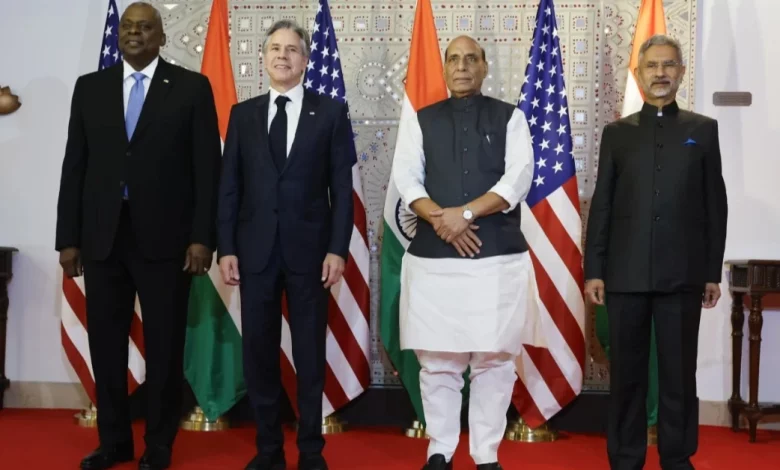Daily Current Affairs for UPSC
Fifth India-US 2+2 Ministerial Dialogue
Syllabus- International Relations [GS Paper-2]

Context- India’s defense minister and foreign minister met their US government counterparts in the fifth India-US 2+2 ministerial dialogue.
About
- Since 2018, 2+2 meetings have been held annually with US leaders.
- Discussions in the 2+2 dialogue covered topics as diverse as the fight against terrorism and explored ways to promote cooperation in cutting-edge technologies such as semiconductors and critical minerals. What are 2+2 meetings?
- The 2+2 meetings are attended by two high-level representatives of both countries, the Minister of Foreign Affairs and the Minister of Defense, who try to strengthen the dialogue between them.
- Such a mechanism allows the partners to better understand and appreciate each other’s strategic concerns and sensitivities, taking into account the political factors of both sides, to build a stronger and more integrated strategic relationship.
- India held 2+2 meetings with ministers from Australia, Japan, Great Britain and Russia.
Overview of India-US Bilateral Relations
- Since India’s independence, relations with the United States have endured Cold War mistrust and alienation over India’s nuclear program.
- In recent years, relations have warmed and cooperation has intensified in several areas of economics and politics.
- Bilateral Trade: Bilateral trade between the two countries increased by 72 percent between 2017-18 and 2022-23.
- The US contributed 18 percent of FDI to India in 2021-22, behind Singapore.
- Defense and Security: India and the US signed a trio of deep military cooperation treaties, starting with the Logistics Exchange Memorandum of Agreement (LEMOA) in 2016, followed by the first Communications Interoperability and Security Agreement (COMCASA) to an agreement 2+2 dialogue in 2018 and then the Basic Exchange and Cooperation Agreement (BECA) in 2020.
- In 2016, the US, unlike any other country, elevated India’s role as a major defense partner.
- Space: The Artemis Treaty signed by India created a common vision for the future of space exploration for the benefit of all mankind. The United States and India cooperate through the Bilateral Civilian Space Joint Task Force.
- Multilateral Cooperation: India and the US cooperate closely in multilateral organizations and forums, including the United Nations, the G20, the Association of Southeast Asian Nations (ASEAN), the International Monetary Fund, the World Bank and the World Trade Organization.
- Along with Australia and Japan, the US and India will join the Quad, a diplomatic network to promote a free and open Indo-Pacific region.
- Nuclear cooperation: a civilian nuclear agreement was signed in 2005. Under the treaty, India undertakes to separate its civilian and military nuclear facilities and subject all its civilian resources to International Atomic Energy Agency (IAEA) safeguards. In return, the US agrees to work for full civil nuclear cooperation with India.
Challenges
- India prefers its strategic autonomy: Even as its engagement with the US strengthens, deepens and expands, India is also aware of the need to maintain strategic autonomy.
- Controversial views: India’s muted criticism of Russia’s 2022 invasion of Ukraine has predictably caused frustration in the West and raised questions about India’s credibility as a security partner.
- Defense Relations with Russia: The United States has expressed particular concern about new weapons flows, such as the S-400 air defense system, because they fuel Russian power, undermine opportunities for US-Indian force interoperability and communications security, and impede sharing of weapon streams existing sensitive weapons technology.
Conclusion
- The evolving relationship between India and the United States is of great importance in shaping the global order of the 21st century.
- To realize the full potential of this partnership, both governments must focus on reducing bilateral and multilateral bottlenecks and chart a course for a comprehensive and strategic global alliance.
- Strengthening the cooperation mechanisms between the two armies is important in China’s increasingly aggressive context.
Source: Indian Express
Practice question:
Q. The 2+2 dialogue between India and the US was started in the presidentship of-
- G Bush
- Obama.
- Trump
- Joe Biden





.png)



